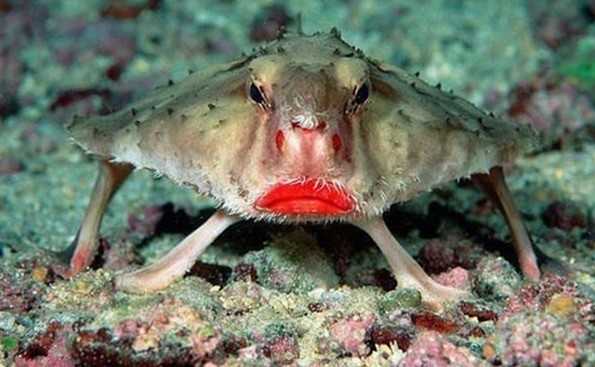Search for information
The Red-Lipped Batfish: Galápagos’ Quirky Underwater Celebrity with a Pouty Predatory StyleNative to the coastal waters of the Galápagos Islands and Peru, the red-lipped batfish (Ogcocephalus darwini) has become an internet sensation for its most striking feature—bright red, pouty lips that contrast vividly with its grayish-brown body. This unusual fish, adapted for life on the ocean floor, trades swimming for "walking" using modified pectoral fins, making it a fascinating example of evolutionary specialization.
June 23, 2025, 2:06 pm EDT

A Fish Out of Water: Adaptations for Benthic Life
- Lips as a Living Billboard
The batfish’s iconic red lips are thought to play a role in mating displays, with males sporting more vibrant hues to attract females. The color may also signal health or genetic fitness, though researchers continue to study their exact function. Beyond aesthetics, the fish has a flattened head and downward-facing mouth, ideal for feeding on small invertebrates and crustaceans hiding in sand or coral rubble. - Walking on Fins
Unlike most fish, it uses sturdy pectoral and pelvic fins to "walk" along the seafloor, reducing energy use in its shallow-water habitat. A modified dorsal fin acts as a lure, resembling a small worm or crustacean to attract prey. Its body shape, resembling a pancake, allows it to blend with the ocean bottom, while small spines on its head provide camouflage among rocks.
Life Cycle and Ecological Role
- From Swimmer to Walker
Juveniles have a more traditional fish-like appearance, with rounded bodies and clear fins, but as they mature, their bodies flatten, and fins transform into walking appendages. Adults reach up to 25 cm in length and are mostly solitary, though they may gather in small groups during spawning seasons. - Galápagos Endemism
Found almost exclusively in the Galápagos, this fish relies on healthy coral reefs and sandy bottoms. While not currently endangered, it faces potential threats from climate change (coral bleaching) and accidental capture in fishing nets. Its unique appearance has made it a flagship species for marine conservation campaigns, raising awareness about the importance of protecting tropical coastal ecosystems.

Golden Shrimp Plant: A Tropical Beauty Lighting up Gardens Worldwide
The Golden Shrimp Plant, scientifically known as Pachystachys lutea, is captivating gardeners and plant enthusiasts with its stunning appearance and unique charm. Native to the tropical regions of Central and South America, from El Salvador to Peru, this evergreen shrub has found its way into gardens and homes across the globe.more

New IMAX Poster Unveiled for Princess Mononoke
A new IMAX poster has been released for the renowned animated film Princess Mononoke directed by Hayao Miyazaki. The 4K restored version of Princess Mononoke is set to hit theaters in North America in IMAX format on March 26.more

The Sweet Allure of Taiyaki: Japan's Iconic Street Food from Edo to the World
In the bustling streets of Japan, a sweet aroma often lingers in the air, drawing crowds to one of the nation’s most beloved treats—taiyaki. For fans of the Lonely Gourmet, the sight of protagonist (Goro) savoring a taiyaki with delighted satisfaction has become an iconic representation of this beloved snack. Shaped like a sea bream (tai), this pastry is not just a culinary delight but a cultural emblem woven into Japan’s historical and social fabric.more

The Ethereal Egret Flower: Nature's Graceful Avian - Inspired Bloom
The Egret Flower, scientifically known as Habenaria radiata, is a captivating orchid species that has long intrigued botanists and nature enthusiasts with its unique and striking appearance. Native to East Asia, this delicate plant is renowned for its uncanny resemblance to a snowy white egret in flight.more

Classic Culinary Treasures of Britain and Ireland: A Gastronomic Journey Through Time
Is there any food more emblematic of British and Irish cuisine than Fish and Chips? This beloved dish involves coating cod in a light flour batter and gently frying it until golden and crispy. Served alongside a generous portion of chips, it is typically accompanied by a choice of creamy mayonnaise or tangy ketchup.more

Stunning Honeycomb Ginger: A Tropical Botanical Gem
The Honeycomb Ginger, scientifically named Zingiber spectabile, is a captivating plant native to the tropical rainforests of Southeast Asia, particularly Thailand, Malaysia, and Indonesia. Revered for its unique appearance and vibrant colors, it stands out as one of the most remarkable members of the Zingiberaceae family.more

Enigmatic Holy Ghost Orchid: A Symbol of Purity and Rarity
The Holy Ghost Orchid, scientifically named Peristeria elata, is a botanical wonder that has long fascinated the world. Native to the tropical regions of Central and South America, including Panama, Costa Rica, Colombia, and Ecuador, this orchid holds a special place in both nature and culture.more

Scientists Unveil Ultra - Precise 3D Tumor Cell Maps and 'Molecular Clocks'
On October 30, in 12 papers published in Nature, researchers from the Human Tumor Atlas Network (HTAN) have created ultra - precise 3D maps of tumor cells by analyzing hundreds of thousands of cells from human and animal tissues. They also developed a “molecular clock” capable of tracking the cellular changes that lead to cancer.more

